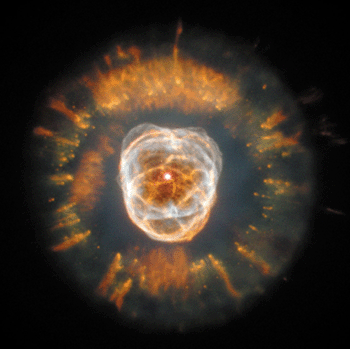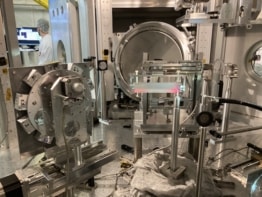By measuring a crucial process in nuclear astrophysics with unprecedented precision, physicists have discovered that stars may live longer than had previously been thought.

During the last century great strides were made in understanding the structure of the universe and the overall processes that drive its evolution. The utter vastness of the cosmos became apparent following the discovery that although our own galaxy is gigantic, it is just one of many billions of galaxies scattered throughout the universe. The sheer physical size of the universe makes it even more remarkable that the evolution of galaxies is directly linked to physical processes that occur on the smallest scales – the reactions between atomic nuclei.
Now recent results by Art Champagne and co-workers at the University of North Carolina in the US look set to overturn a long-held view about one of the most important nuclear processes that occurs in stars (P Bertone et al. 2001 Phys. Rev. Lett. 87 152501).
Stellar evolution
Our current understanding is that the outpouring of energy from stars, and the continual conversion of one element to another inside them, is the direct result of reactions between nuclei. There are many different types of stars and each has its own unique set of nuclear reactions that change in character as the star evolves, in particular towards the end of its life. By looking at the whole picture, it has become clear that the evolution of the universe is driven by several thousand different nuclear reactions, many of which we have limited or no knowledge of at all.
It is almost impossible to measure all of these reactions on Earth, so it is vital to identify the most important ones and concentrate our efforts on understanding them. This is a sensible approach since certain macroscopic properties of a stellar process are often dominated by the properties of a single nuclear reaction.
According to our current knowledge, the main source of energy that sustains burning stars for millions to billions of years comes from two different nuclear processes, both of which convert hydrogen to helium. The first is called the p-p process and dominates the Sun. It involves the fusion of two colliding protons to produce deuterium (an isotope of hydrogen that contains one proton and one neutron), a positron and a neutrino via the weak force. The deuterium, in turn, interacts with another proton by the strong nuclear force to form helium-3, which can then combine with another helium-3 nucleus to finally form helium-4 and two protons. The energy released in this process is due to the final particles having smaller mass than the initial particles.
The second process, known as the CNO cycle, is not important in the Sun but it does dominate heavier stars. Here protons interact with light nuclei, such as carbon, nitrogen and oxygen, rather than with other protons. The actual reaction process is the fusion of a proton with the nucleus, resulting in the emission of a high-energy gamma ray. In fact, the sequence is really a cycle of reactions passing through isotopes of carbon, nitrogen and oxygen, ending with the reaction 15N + p –> 12C + 4He. The carbon nucleus in the final state is then available to go through the sequence again. The net result of this cycle is the conversion of hydrogen to helium, with the carbon nuclei simply acting as catalysts.
For each of the two processes, the factors that dominate the energy output are the mass difference between the initial and final particles, and the rate at which the reactions can occur. One of the slowest reactions in the CNO cycle is the fusion of protons with nitrogen-14 nuclei to produce oxygen-15. The rate of this reaction therefore has an important influence on the energy released by the CNO process and, consequently, on the brightness and lifetime of a star.
Challenging measurement
Over the past 40 years nuclear physicists have been trying to measure the rate of the reaction p + 14N –> 15O, yet there is still considerable uncertainty about its value. The problem lies in the fact that it is difficult to measure the rate at the thermal energies relevant to stellar interiors. Although these temperatures are high, on the order of 100 million degrees, the corresponding reaction rate is extremely small, making it difficult for it to be measured directly in the laboratory.
In 1987 Claus Rolfs and co-workers at Münster University in Germany and Toronto University in Canada investigated this reaction directly by detecting the emission of high-energy gamma rays from the oxygen-15 nuclei (U Schröder et al. 1987 Nucl. Phys. A467 240). However, the rate was only measurable for protons corresponding to effective temperatures many times hotter than the interior of stars. Rolfs and colleagues therefore deduced the reaction rate at lower temperatures by extrapolating the measured data. For this extrapolation to work successfully, however, they had to fit a model of the reaction process to their measurements.
Such a model had to include the possibility that the reaction proton could be captured into an excited state of oxygen-15 that then de-excites by emitting a gamma ray – a route called resonance capture. The model also had to account for the direct process in which the proton is captured by nitrogen-14 but not into an excited state of oxygen-15.
What makes this modelling particularly difficult is that the excited states of oxygen-15 – including those that are lower in energy than the threshold for fusion – can spread their influence over a wide energy range. As a result, Rolfs and co-workers found their model had to include direct-capture and resonant contributions from several oxygen-15 states to explain the data at high temperatures, including a state that lies some 500 keV below the energy threshold. With this model, they could extrapolate the reaction rate to astrophysical temperatures.
Soon after Rolfs’s group published its work, however, it was speculated that the extrapolation of the fit might be incorrect since it predicted that the sub-threshold state had a larger energy spread than expected. According to the uncertainty principle, this meant that the state had a lifetime of only 0.1 femtoseconds (1 fs = 10-15 s).
Now Champagne’s team at North Carolina has measured the lifetime of the state directly and shown that it is some 15 times longer than the value inferred by Rolf and co-workers. The North Carolina lifetime measurement is very impressive as it pushes to the limit a technique that is based on the slow down of a de-exciting nucleus. The radiation that is emitted by the nucleus as it decelerates is Doppler shifted by an amount that is related to the lifetime of the state.
Now that the lifetime of the sub-threshold state has been shown to be much greater than previously thought, we realize that its influence on the rate of the p + 14N –> 15O reaction at astrophysical energies is significantly smaller than that inferred by Rolfs and co-workers. The upshot is that the astrophysical fusion rate is about a factor of two smaller than previously accepted. As a result, the CNO cycle will release energy at a slower rate, thereby increasing stellar lifetimes. For example, the main-sequence stars in globular clusters will be several hundred million years older than we thought.
The experiment confirms how processes associated with the smallest units of matter have an enormous influence on the evolution of the largest structures in the universe. Moreover, it shows that a phenomena lasting just 10-15 seconds can significantly affect the lifetimes of stars.



